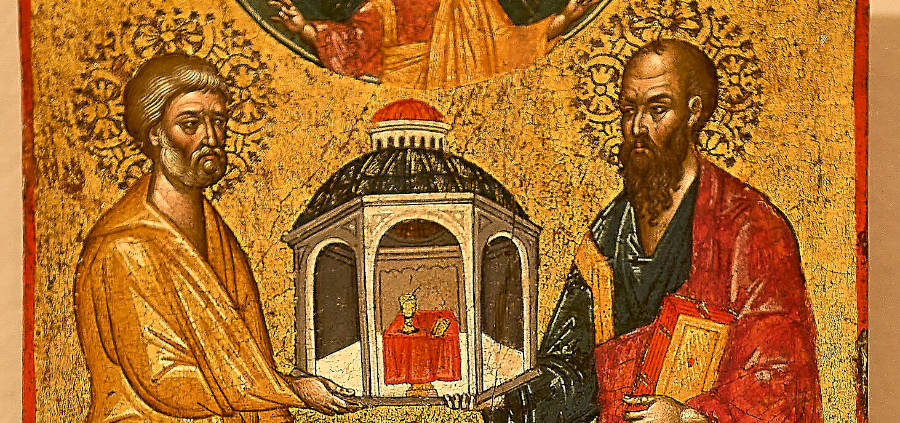Temples of the Holy Spirit by Pauline Little
This text was originally presented as a reflection at the Mass for the Feast of the Dedication of the Lateran Basilica at St. Thomas More Chapel at Yale University on November 9. We are grateful to the author for permission to reprint it here.
In the 1955 short story “Temple of the Holy Ghost” by the prolific Catholic writer Flannery O’Connor, the two sisters Joanne and Suzanne jokingly call themselves “Temple one” and “Temple two.” These self-proclaimed nicknames were inspired by an encounter with one of their teachers, Sr. Perpetua, who had given them a lecture on what to do if a young man should try to behave in an “ungentlemanly manner” with them in the back of a car. They were to say, “Stop sir! I am a Temple of the Holy Ghost.” Later in the story, the 12-year-old protagonist, only referred to as “the child,” realizes that even with her most wicked, judgmental, and condescending behavior that she, too, is a temple of the Holy Ghost. O’Connor continues this theme when the child’s imagination and fascination with an intersex person who is put on display as a “freak” in the traveling circus serves as another moment of realization that they are all carriers of God’s grace.
This is not unlike Paul’s exhortation when writing to the Christian community of Corinth, reminding them, and us here today sitting inside this church, that we are also God’s building, not just this physical structure. We are also the temple of God, and we are holy, he writes. There is both a gift and a responsibility to that identity. One of my old students back in Chicago used to wear a shirt that said, “Don’t just go to Church, be the Church.” How do we honor that which is sacred in ourselves and each other, knowing that we are also temples of the Holy Spirit, made in the image and likeness of God? Each one of us—including our enemies, including the stranger, or whomever else we deem as “the other.”
This temple metaphor is also used in today’s gospel, where Jesus proclaims that he, himself, is the temple that would be destroyed and raised up again in three days. Here, Jesus is already being revealed as the Messiah and that he is fully aware of the persecution that awaits him at the hands of religious and political leaders. Jesus constantly took a stand against these authorities who contributed to a system that oppressed others spiritually and economically. The destruction of which he spoke about was ultimately prompted by people who saw him as a threat to their own power and influence. This heated exchange with the crowd in the Gospel of John happens directly after Jesus has an angry outburst, turning over tables and chasing vendors out of the Jerusalem temple with a whipping cord that he made.
What seemed to others as normal everyday temple activity was, to Jesus, not action pointing to God. They were self-seeking and making a mockery of that sacred space. It was essentially the ultimate commodification of religion: “Stop making my Father’s house a marketplace,” Jesus says. As we apply that command to this moment in history, how is religion being used to prop up and advance personal and political agendas that serve a different god? With a well-formed and discerning eye, can we recognize when our Catholic faith is used to promote values and issues that are completely antithetical to the Good News of God’s mercy, generosity, kindness, preferential option for the poor, and love for all people who are made in God’s very own image—who are themselves temples of the Holy Spirit? The use of faith to promote non-Christian ideals may not be traded in for money directly, but rather for power and influence.
Throughout his life and death, Jesus shows us what is true worship: being deeply connected to God, which is evidenced by a life of loving one’s neighbor, caring for those on the margins, being a peacemaker, and calling out injustice and hypocrisy as Jesus did with his own people and their leaders.
If we take ourselves seriously as Temples of the Holy Spirit, how do we offer true worship? Our Catholic faith invites us to keep cultivating a disposition of being other-oriented. After all, we worship a God who washes our feet and tells us to do the same for others. Whether it’s at the soup kitchen, on the street, in our own families, or with our friends and suite mates, there are always opportunities to “be the church” in service to others.
How do our Scriptures and the Catholic tradition shape our imagination on where, and in whom, God is present? In Pope Leo’s first apostolic exhortation, Dilexi Te, meaning “I have loved you,” he writes, “Love for the Lord, then, is one with love for the poor. . . . This is not a matter of mere human kindness but a revelation: contact with those who are lowly and powerless is a fundamental way of encountering the Lord of history. In the poor, he continues to speak to us.” But are we listening? Are we listening to God when we read or watch the news about the rising cost of health care for the most vulnerable, or the millions impacted by the pause in SNAP funding, or people being too afraid to attend church for fear of being separated from their families, or the devastating effects of starvation and sexual violence as a result of ongoing wars? God is speaking to us through these real-life situations. Are we listening?
In this month of All Souls where we commemorate our deceased loved ones, we are also brought into greater realization about the finitude of our existence on earth—the slow and eventual destruction of our own bodily temples over time. How are we making the most of our temporary presence in this world by offering true worship to the living God all around us?
May this St. Thomas More community, our faith, and the Eucharist which we consume and celebrate continue to form us and make holy the temple of our bodies in service to all of God’s people. ♦
Pauline Little is assistant chaplain at St. Thomas More Chapel at Yale University.





Leave a Reply
Want to join the discussion?Feel free to contribute!